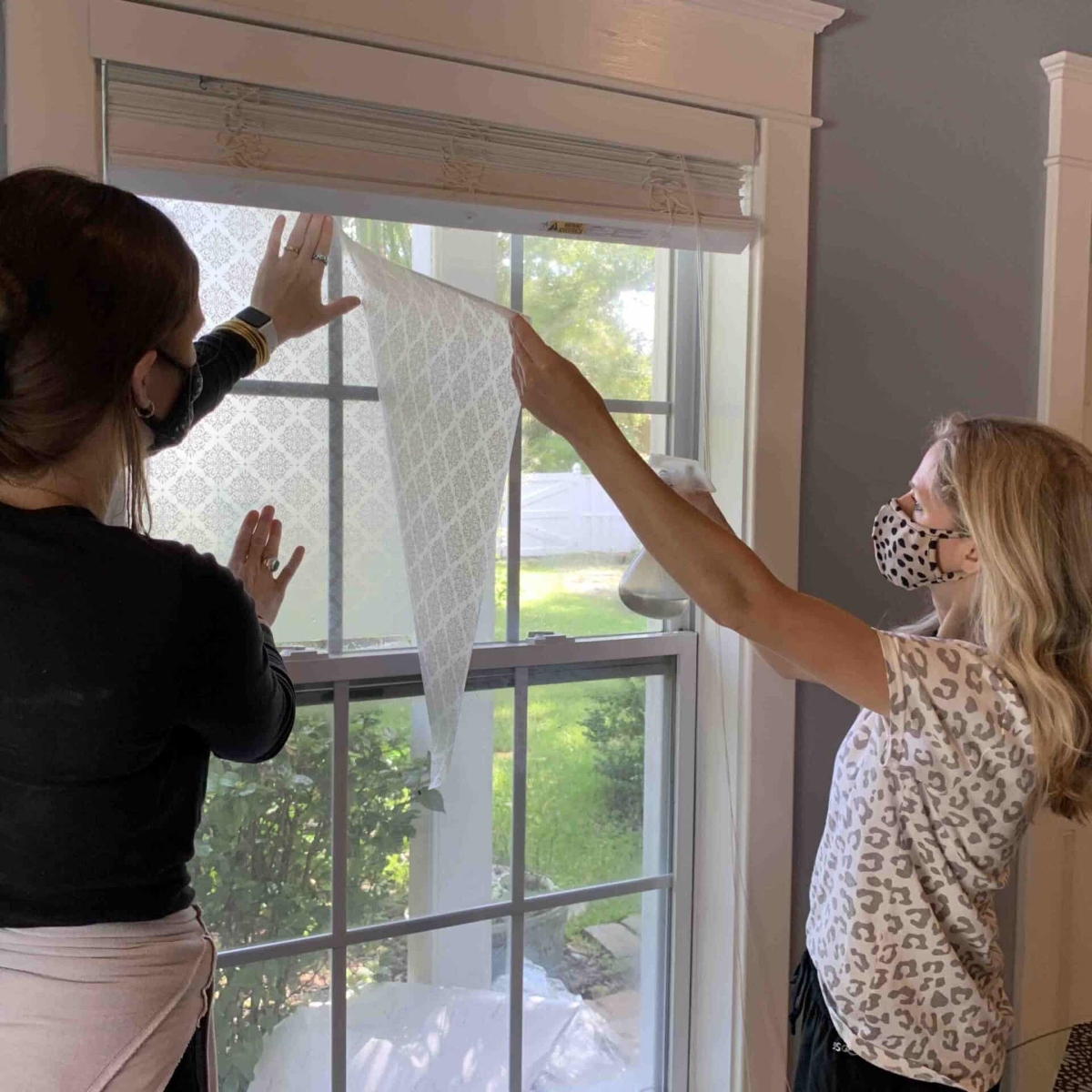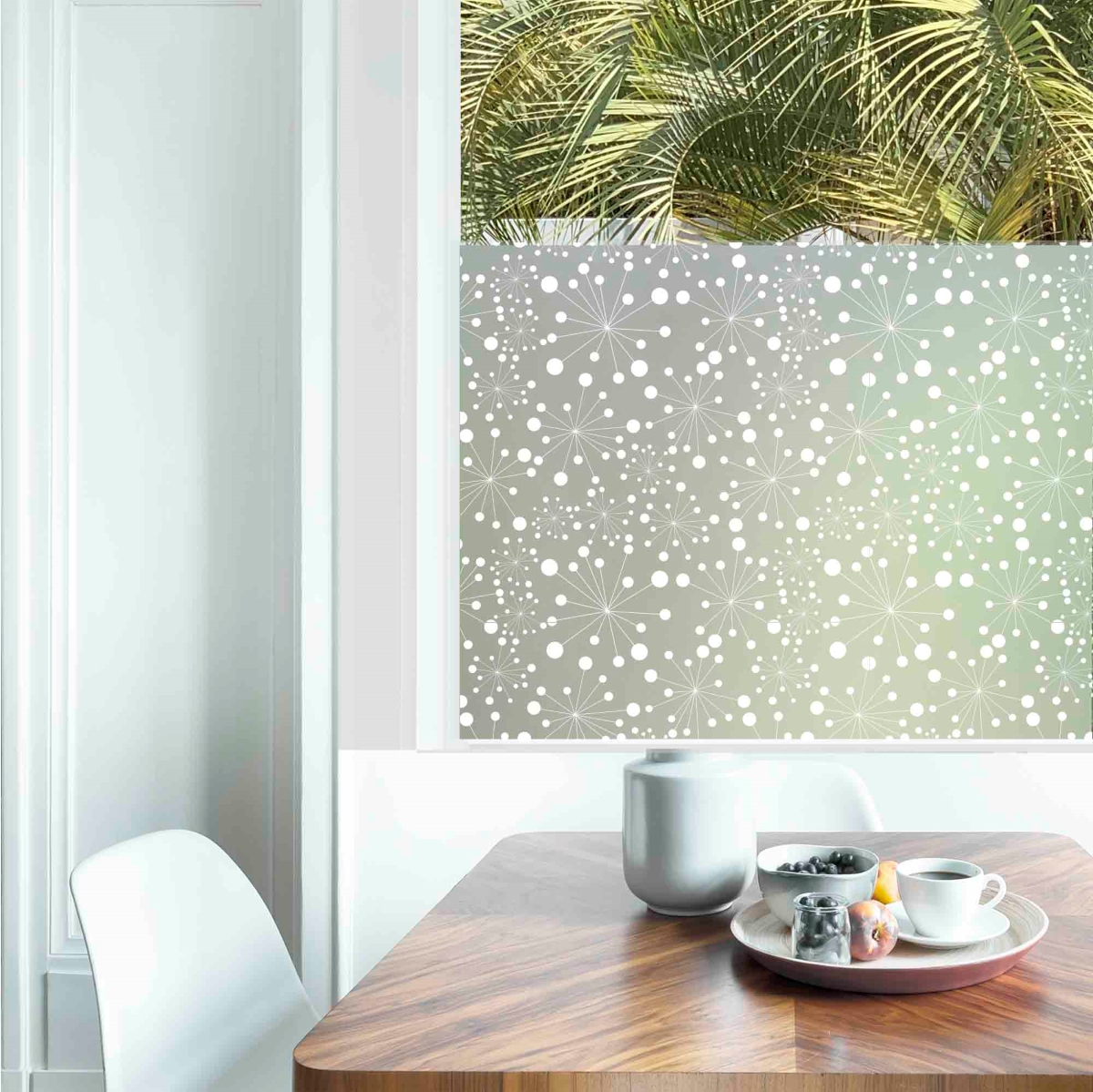We may earn revenue from the products available on this page and participate in affiliate programs. Learn More ›
More than just a decorative finish, frosted glass offers the benefit of adding privacy to windows or glass doors without blocking the passage of light. Frosted glass is great for windows that are a bit too close to a neighboring property, or for ensuring bathroom window privacy. While professionals frost glass through sandblasting, a do-it-yourselfer can achieve a similar effect with one of these four accessible methods of how to frost glass.
5 Ways to Frost Glass
Do you want the glass to be permanently frosted, or do you wan the option of changing your mind? How handy are you with an air compressor, or at least a small paint brush? These are some of the questions that will help you decide which of the following frosting methods is best for your project.
1. Spray Paint
Several manufacturers produce paints that can create a frosted appearance on glass surfaces. One of the most popular options is Rust-Oleum’s Frosted Glass spray paint, although there are also products on the market that can be applied with a roller.
Frosting a window with spray paint is easy. Here’s how it’s done:
- Clean the glass thoroughly and tape off the window or door frame as well as any other nearby surfaces you want to protect from the paint.
- Make sure you paint in a well-ventilated space. If you can’t work outside, open windows and use a fan to generate a cross breeze. Many manufacturers recommend wearing a respirator mask when applying spray paint indoors.
- Apply a thin coat of the spray paint, working back and forth in one direction, and let it dry. Depending on the product you choose, drying should take about 10 to 15 minutes.
- Apply additional coats if you want greater opacity, letting the surface dry between each coat.
For the best results, it’s important to apply evenly. “It can be very difficult to control and get a nice, even, uniform finish,” notes Thomas Patterson, director of new product development and technical training for Glass Doctor, a Neighborly company.
Frosted paint finishes can be applied only on the interior surface of a window and are vulnerable to scratching. Yet, while frosted glass paints are a bit lacking in durability, they check the boxes for convenience, price, and flexibility. For less than $20, you can gain a little style and privacy. Wash windows with frosted paint gently with a soft cloth, using household window cleaner or liquid soap and water. Later, if you tire of the look, you can remove the finish with a scraper, some acetone or lacquer thinner, and a fair amount of persistence and elbow grease.
2. Window Film

Like spray paint, window films are an inexpensive, nonpermanent way to create a frosted effect on glass surfaces. Also like spray paint, film for windows should be applied only to the inside of windows.
Window frosting films are available in either static-cling or adhesive varieties. Both are removable, although static-cling films are much easier to reposition and remove. “They look just like frosted glass when you’re done, and they’re much more durable than paint, without the fumes … and you can always peel the film off,” says Patterson.
To install a static-cling film:
- Wash the window using glass cleaner and a lint-free cloth. Dry thoroughly.
- Measure the window and cut the film to size, leaving some excess on the edges.
- Peel off the protective backing from the window film.
- Fill a spray bottle with water and spritz the window. (Some manufacturers recommend adding a few drops of dish detergent to the water.)
- Apply the film to the glass, working your way down the window and using a squeegee to remove air bubbles as you go.
- Wipe away excess moisture from the film and window frame.
- When the window is dry, use a utility knife to trim the excess film along the edges.
Frosted window films start at about 80 cents per square foot. The best window films will be more expensive than frosted paints, but they’re more durable. They’re also available in a wealth of decorative options beyond frosted glass window films, including etched, textured, and even stained-glass patterns. Cleaning an opaque window film is easy—just use soap water and a soft cloth, and avoid abrasives, harsh chemicals, and ammonia-based products.
3. Switchable Films
For a high-tech, luxe option, consider switchable films, which are gaining ground in home design. These films allow a traditional window to function like pricey smart glass, changing from clear to opaque with the flip of a switch. Although they require electric wiring and professional installation, manufacturers are starting to introduce more DIY-friendly options, so stay tuned.
4. Etching Cream

Etching glass with a glass etching cream can give windows a permanent frosted effect. They’re beloved by crafters, who use them to embellish glassware and decorative accessories. Armour Etch glass etching cream leads the pack in popularity.
If you choose this route, apply the cream carefully, and closely follow the instructions on the package. Here’s the basic process:
- Clean the glass thoroughly with glass cleaner and a lint-free cloth.
- Mask off sensitive areas with painter’s tape.
- Since etching cream has an unpleasant odor and is highly corrosive, make sure the workspace is well ventilated, protect nearby surfaces, and put on protective gloves, glasses, and a mask.
- Use a paint brush to apply the cream to the glass surface, covering it completely but keeping the layer thin so the cream doesn’t drip.
- Let the etching cream sit for the time specified in the manufacturer’s instructions.
- Rinse off the cream with warm water.
Etching cream can be used on the inside or outside of windows, although it’s generally used on the interior surface, and costs about $14 for a 2.8-ounce bottle. Depending on the size or number of windows you plan on frosting, this approach may be more expensive than either spray paint or film.
5. Sandblasting
If you want permanent results, sandblasting is the traditional approach for frosting glass. Though sandblasting is typically the domain of professionals, a competent DIYer can rent a compressor, or even pick up a portable kit at a home improvement store. “A homeowner could do it,” says Patterson, without a lot of prep work or expense. “They make media grit that’s so consistent now … and there are nice little mini sandblasting kits. You can take the sash out to the garage or backyard, sandblast pretty quickly, and get a nice, uniform finish,” he says.
A portable kit typically costs less than $200 and may come with a small amount of blast media. Protect the window frame and other sensitive areas with sandblasting tape, and wear long sleeves (ideally, a protective suit), safety goggles or glasses, sandblasting gloves, and a respirator mask.
While any one of these four methods will create frosted glass, the approach you choose will depend on the degree of permanence desired, how much you want to spend, how much work you’re willing to do, and how fussy you are about the results.
Final Thoughts
Any of these methods can add frosting and privacy to glass doors and windows. Spray paint, films, and etching are less permanent than sandblasting, but easier for most DIYers. Although sandpaper is mentioned as a way of frosting a glass door or window by some DIYers, Patterson advises against it. He says it is difficult to get an even finish, the process requires expensive sandpapers, and it’s possible to break the glass while sanding. It’s best to consider one of the four ways above for frosting glass.

